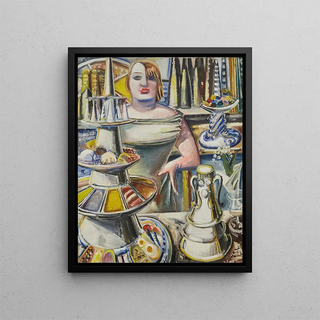Art print | Bardame barmaid - Paul Kleinschmidt Source: Reproduction | Bardame barmaid - Paul Kleinschmidt


View from behind

Frame (optional)
In the vibrant world of art, some works manage to capture the essence of their era while transcending the limits of time. "Reproduction Bardame barmaid - Paul Kleinschmidt" is one of these creations that evokes a unique atmosphere, a frozen moment where conviviality and intimacy blend in a warm setting. This piece, both simple and complex, immerses us in a universe where everyday life becomes art, where every detail tells a story. The artist succeeds in immortalizing a scene of life that, although seemingly mundane, is imbued with subtle poetry, inviting the viewer to reflect on the nuances of human existence.
Style and uniqueness of the work
Paul Kleinschmidt's style in "Bardame barmaid" is distinguished by a pictorial approach that combines realism and impressionism. The vibrant colors and play of light infuse a particular dynamism into the scene, making the atmosphere of this bar, where friends gather, almost tangible. The composition is carefully thought out, with each element having its place in the visual narrative. The barmaid, the central figure of the piece, is depicted with meticulous attention, her gestures revealing ease and familiarity with her environment. The details, whether reflections in the glasses or shadows cast on the counter, testify to remarkable technical skill. This focus on everyday representation makes the work a true ode to life, where each viewer can find echoes of their own experiences.
The artist and his influence
Paul Kleinschmidt, a multifaceted artist, has established himself in the art scene thanks to his ability to capture moments of life with rare sensitivity. Influenced by the great masters of painting, he has developed a style that is uniquely his own, blending tradition and innovation. His work is part of a process of exploring human emotions, and "Bardame barmaid" is a perfect example. The piece does not merely depict a scene; it evokes feelings of nostalgia, happiness, and sharing. Kleinschmidt was also a keen observer of

Matte finish

View from behind

Frame (optional)
In the vibrant world of art, some works manage to capture the essence of their era while transcending the limits of time. "Reproduction Bardame barmaid - Paul Kleinschmidt" is one of these creations that evokes a unique atmosphere, a frozen moment where conviviality and intimacy blend in a warm setting. This piece, both simple and complex, immerses us in a universe where everyday life becomes art, where every detail tells a story. The artist succeeds in immortalizing a scene of life that, although seemingly mundane, is imbued with subtle poetry, inviting the viewer to reflect on the nuances of human existence.
Style and uniqueness of the work
Paul Kleinschmidt's style in "Bardame barmaid" is distinguished by a pictorial approach that combines realism and impressionism. The vibrant colors and play of light infuse a particular dynamism into the scene, making the atmosphere of this bar, where friends gather, almost tangible. The composition is carefully thought out, with each element having its place in the visual narrative. The barmaid, the central figure of the piece, is depicted with meticulous attention, her gestures revealing ease and familiarity with her environment. The details, whether reflections in the glasses or shadows cast on the counter, testify to remarkable technical skill. This focus on everyday representation makes the work a true ode to life, where each viewer can find echoes of their own experiences.
The artist and his influence
Paul Kleinschmidt, a multifaceted artist, has established himself in the art scene thanks to his ability to capture moments of life with rare sensitivity. Influenced by the great masters of painting, he has developed a style that is uniquely his own, blending tradition and innovation. His work is part of a process of exploring human emotions, and "Bardame barmaid" is a perfect example. The piece does not merely depict a scene; it evokes feelings of nostalgia, happiness, and sharing. Kleinschmidt was also a keen observer of






